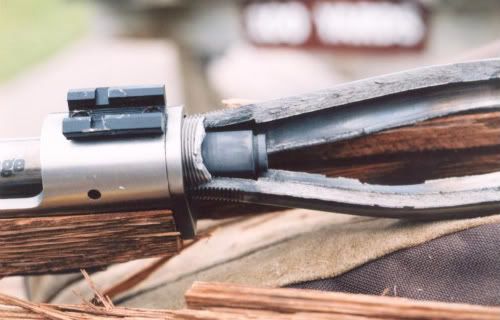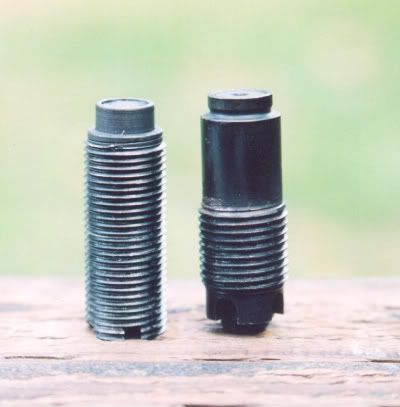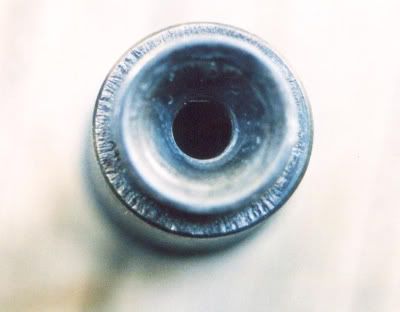Randy Wakeman at http://randywakeman.com/HowToBlowUpASavage10ML.htm wrote:
A) The “Gas-Cutting” Breechplug Theory
This newly coined term does not bear close scrutiny. Throat erosion is common in all rifles and is a known quantity that has been around for as long as I can remember. The gas temperature of propellant is somewhere around 5000 degrees F. Whenever you burn a lot of powder in a small hole, as in the .220 Swift, the .22-250, and the .204 Ruger you have the potential for “barrel burners.” Throat erosion begins at the chamber area and migrates towards the muzzle. It never has been a safety issue at all. The rifling depth on most center-fire rifles is only 3.5 thousandths of an inch or so, about the depth of a piece of newsprint. It doesn't take much to erode the rifling to the point where it affects accuracy. Not a safety issue at all, but if you get a .220 Swift barrel nice and hot and keep blazing away the accuracy life of that barrel is diminished considerably. It is not unusual at all for high-volume varmint shooters to wear out their barrels within 3000 – 5000 rounds and screw on a replacement barrels to get accuracy back. This is considered common knowledge.
All flash holes and breechplugs erode. This too is considered common knowledge and normal wear. As Dr. Gary “Doc” White has long noted, most muzzleloaders don't shoot nearly enough to notice. The breechplug is a wearing part. Not a safety issue at all, but particularly when the flash hole opens up it may become an accuracy issue. That's the whole idea behind the original Henry Ball patent-- flash holes wear, regardless of propellant. With the patented ventliner (a replaceable flash hole) you get brand new muzzleloader accuracy without having to change the whole breechplug, just the ventliner. The idea that “gas-cutting” is new, unusual, or unique to the Savage is false on its face. I've personally shot Thompson and Knight breechplugs to the point of being so visibly eroded and opened up, the worn-out breechplugs had to be replaced. Shoot any breechplug long and hard enough, it can show wear. All normal wear, with the opening of the flash hole the part that may affect pinpoint accuracy.
B) The Breechplug as a “Perfect Seal” Theory
This one is easily disproved. No breechplug seals “perfectly.” If they did, no muzzleloading manufacturer would bother telling you to lube the breechplug threads. They all do, of course, as the threads do most of the sealing. But, the threads do not at all make a breechplug a “perfect seal.” A perfectly sealing breechplug would be completely worthless. Look at any breechplug-- of course it isn't a “perfect seal,” as there is a nice hole going straight through the middle of it. If there was no flash hole, your primer would not be able to do its job. For anyone so inclined to think a breechplug is a “perfect seal,” you might want to install one in the middle of your bass boat-- and don't be all that surprised when it eventually fills with water and sinks. So much for “perfect sealing breechplugs.”
C) Fully Threaded Breechplugs Are Desirable?
The unthreaded nose on a breechplug is the better, stronger breechplug-- not the other way around. It is the nose of the breechplug that is in direct contact with the hot gas, not the threads that are behind it. The unthreaded nose of the breechplug protects the breechplug threads, having threads in direct contact with the primary powder charge exposes them to hot gas and particulate matter. And what about barrel strength? Cutting threads into a barrel of course weakens it at that point, which is exactly what you would have to do with a fully threaded breechplug.
This is the breech from a Russian 122 mm M1910 howitzer combined with 105mm H37 howitzer barrel. The Howitzer breechplug is as far from "fully threaded" as can be imagined.
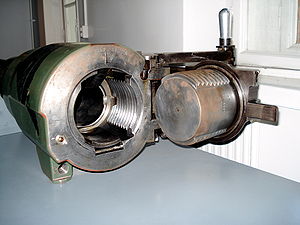
This is the overhead view of the same Howitzer. As the Howitzer is a breechloader, not a muzzleloader, you'll note the huge, smooth, threadless concave area required so the breechplug can be swung in and out of battery.
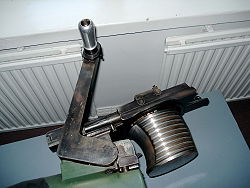
Most modern inline breechplugs have unthreaded portions at the nose area, for the simple reason that they are better-- doing a good job at protecting the breechplug threads than running threads all the way to the nose. The above image is a picture of my spare Encore Endeavor breechplug, the "Speed Breech XT." While the idea of being in a hurry to get your breechplug out may make some sense with heavy fouling, corrosive propellants, it makes a lot less sense with far cleaner, non-corrosive smokeless. The interrupted threads of this T/C plug were inspired by the Howitzer. You'll note that more than half of the breechplug has no threads at all and the stepped snout is completely threadless.
A breechplug, with a smooth unthreaded portion at the nose is a superior design. It protects the threads of the breechplug and is also stronger than a fully threaded plug by having superior column strength and lack of stress risers. It was co-designed by both Savage Arms and Henry Ball and is used simply because it is superior in both respects. As a matter of fact, I discussed this breech plug with both Henry and Ron Coburn. The initial design had passed testing, but Henry wanted an extra turn of the strong, coarse threads added to what by now has long been the standard Savage breech plug. Ron Coburn, a firearms designer and multiple patent holder in his own right, asked Henry why, as it already exceeded all recognized engineering standards. Henry replied, "Because everything about this gun has to be the best that has ever been. I always err on the side of caution and safety." Ron Coburn smiled, complimenting Henry on the way he looked at things. "It will be the best that has ever been, Henry. We are raising the bar on standards in the industry." That extra turn of threads was added without delay.
D) How Pressure Works In a Muzzleloader
This is important and not commonly understood. The complete bullet travel time of a saboted projectile in a Savage 10ML-II is very, very short-- less than 1.5 milliseconds. It takes 300 – 400 ms for the average human to blink an eye. Let's say you are a fairly fast eye-blinker at 300 milliseconds. In that period of time, 200 shots could have traveled the full length of a Savage 10ML-II barrel and exited.
What does this have to do with pressure? Quite a lot, actually. Peak pressure in a muzzleloader happens nowhere near the breechplug at all, it always follows the base of the sabot. Peak pressure in a representative load of Accurate Arms 5744 happens after the length of the powder column, and after the sabot has moved 2.5 inches. It is absolutely, positively nowhere near the breechplug at all. Of course, the sabot doesn't stop there-- it continues to move, rapidly exiting the muzzle about one millisecond later. After the peak pressure node, the pressure rapidly drops. The breechplug of a Savage 10ML-II sees no significant pressure, nothing remotely approaching peak pressure.
Again, I'll call upon Hartmut Broemel, designer of "QuickLOAD" and "QuickDESIGN" ballistics analysis software for his description of pressure distribution.
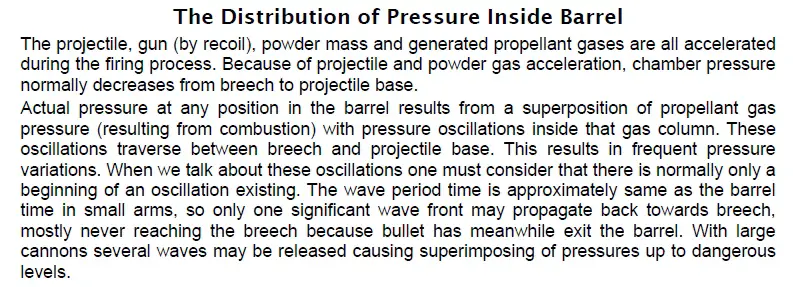
If you give this a little thought, it will quickly become obvious to you. If the entire barrel was ever pressurized at a constant level, after every single shot that little cheap, tin-can of a 209 primer would be shattered into bits or quickly flattened like a bug on a windshield. It doesn't happen in the Savage, nor does it happen in any muzzleloader of course. Peak pressure never reaches the breechplug at all, not even enough to destroy a chintzy 209 primer. No Savage breechplug has ever failed despite Savage's intense, destructive testing of the 10ML before the first one was ever sold. It cannot plausibly fail as it sees no significant pressure as compared to the base of the sabot far downstream.
How Do I Blow Up a Savage 10ML-II?
Well, I didn't tell you it was going to be easy. If you are a reasonable person and use Savage-recommended loads, you're just out of luck. You cannot possibly damage your Savage 10ML-II, much less destroy it. Savage-recommended propellants, charge weights, and allowed weights of saboted bullets simply do not make enough pressure to come remotely close to damaging a Savage 10ML-II. That's been the idea all along, for the last ten years of continuous 10ML production. The laws of physics prevent that.
However, any steel tube can be destroyed if you try hard enough, including Howitzers and heavy Naval guns-- they all have been. There are two basic strength values to steel; 2% yield strength and tensile strength. If you really want to destroy a Savage 10ML-II, you are going to have to find a way to exceed the tensile strength of the Savage's proof-tested, certified steel barrel. Tensile strength is the pressure at which steel pulls itself apart. Please bear with me, I'll try to get you there.
For starters, you might want to try a double charge of powder-- a dangerous, Savage prohibited load. So, a double-charge of powder and a 250 grain saboted bullet might put your shoulder out of joint, or bounce a scope off your head in a belated attempt to talk you out of it. You won't be able to hit anything, of course, as the integrity of your sabot is long gone. It is a dumb thing to do, but will develop a peak pressure in the area of 60,000 PSI-- not enough to destroy your Savage. By the way, this is not a load “recommendation,” folks. Neither is shooting out your ramrod, but dozens of people have done that and managed to ring a Savage barrel, but not destroy it.
Okay, so let's try something else, thrill-seekers. How about a Savage “max charge” of powder, then a 250 grain sabot, then another 250 grain sabot. Well, your shoulder is out of its socket again and that pesky scope is likely bouncing off your head once again, but no-- the peak pressure you developed is once again in the general vicinity of 60,000 PSI and it is unlikely you damaged your gun.
It is redundant testing like these loads (and more radical ones) that Savage has conducted for years (along with independent folks like Barnes Bullets, Western Powders, etc.) that makes damage to the 10ML-II with a Savage-recommended load a practical impossibility. It also exposes Mr. Toby Bridges as a horrible, lousy liar who is also supremely technically incompetent. Though attempted extortionist Bridges' completely unsubstantiated story about his incident from nearly six years ago has changed constantly, the original claim was that he was using 44 grains of Accurate Arms 5744 and a 250 grain Hornady SST. Problem is, 44 grains of AA 5744 just cannot physically make enough gas with a 250 grain SST to possibly damage a 10ML-II. The “Toby Rifle” was examined by several experts and the universal conclusion was there was no problem with the metallurgy at all-- it was a simple, classic, horribly severe over-pressure situation not possible with any Savage load.
For the last several years, Mr. Bridges has been begging one and all to send him pictures of a failed Savage, ostensibly still because he is still stinging from his discharge under "less than honorable conditions" from Savage Arms. After all these years, Toby apparently finely got his wish. A fellow from Canada sent Toby pictures of a rifle that he allegedly blew-up and further claimed that he was using 42.5 grains of SR-4759 and a 250 grain Barnes. All of this is more than a bit odd, as we don't have any witnesses, no sworn statement, no corroboration, no professional investigation of the incident, and no proper examination of the rifle-- or any examination of the rifle at all for that matter. Of course, Mr. Bridges personally knows nothing of the incident at all; he just got some Don Henley “Dirty Laundry” to pollute his site with.
There is a very big problem here, for anyone that knows anything about internal ballistics, though. 42.5 grains of SR4759 and a 250 grain Barnes sabot cannot damage a Savage 10ML-II. A quantity of 42.5 grains of SR4759 and a 250 grain sabot can't possibly make enough pressure in a half inch hole to do any damage. Puzzled by all this, I called Savage and was surprised to learn that they have never heard from this fellow, or anyone connected with this fellow. It makes no sense.
The Grand Finale
After all this, I feel I owe my readers a bit of an apology for going on in such detail. I think it is important, though, to get a full and complete picture of what is plausible and what is not. The theoretical problems covered so far are not at all plausible. I received a voice mail from a gentleman by the name of Bob Stevens, a Savage 10ML-II fan from Idaho. Naturally, I promptly returned the call. Bob had just blown up his Savage 10ML-II.
Bob is 75 years old, an experienced hunter and reloader. He fell in love with his Savage 10ML-II and had had great success with it in the field. Yes, Bob blew up his Savage 10ML-II. Bob was uninjured, but the rifle sounds like quite a mess. A big difference here. While Bob was completely uninjured (except for his pride), Bob Stevens knew exactly what happened.
Bob's load was 43 grains of SR4759 and a 250 grain SST. Bob loaded his Savage 10ML-II, intending to do a little target shooting, but the wind was so bad he thought the better of it. He knew that there is never an excuse for storing a loaded muzzleloader, but I guess at the time he figured one night wouldn't hurt. Bob also knows what every muzzleloader should know, that being that the use of a witness mark on the ramrod absolutely, positively, mechanically prohibits any double loading or bench errors.
The next day the wind had diminished. Happy at the prospect of being able to go out and shoot, Bob grabbed his trusty 10ML-II and headed out forgetting that he had already loaded it. Bob knows that confirming that a Savage 10ML-II is unloaded is quite easy, as all you have to do it drop the factory ramrod into the muzzle and it will end up flush with the muzzle, instantly telling the shooter that the gun is indeed unloaded. But, his mind was on other things so that wasn't done.
By now, you can probably guess what is coming. Bob completely loaded his already completely loaded Savage. Down went another 43 grains of SR4759, down went another 250 grain SST. Sure, Bob had a witness mark but it doesn't do you much good if you don't use it. Bob also didn't notice that his loading rod didn't go down as much as normal, as it was left protruding the additional combined length of the extra powder charge column, the extra sabot, and the extra 250 grain SST. Bob quickly primed the gun and fired, and the gun came apart.
The chocolate layer cake load that Bob constructed consisted of seven components: primer, powder, sabot, bullet, powder, sabot, bullet. You have to break just about every rule in the book to get there, but it happened. Using information from Hartmut Broemel of Babenhausen, Germany, and Johan Loubser of Western Powders, I ran the numbers to get a rough idea of the peak pressure potential of that load that happened 2 milliseconds after Bob hit the Accu-Trigger. The maximum pressure potential of that load exceeds 316,000 PSI, roughly nine times the pressure of any Savage recommended load. That is of course more than ample pressure to destroy any commercially available shoulder-fired weapon I can think of. The SAAMI MAP for the .50 BMG, for example, is 54,000 PSI, with nothing running higher than 65,000 PSI MAP that I can think of.
